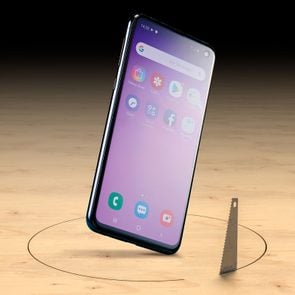Encrypted Phones: What It Means and How It Works
Updated: Nov. 04, 2022

Don't let the term "encrypted phone" intimidate you. It's a feature you probably already have and use on your phone without knowing it—and that's a good thing.
Encryption may sound like a tech buzzword, but even if you’re not tech-savvy, encryption is probably a very important part of your life. More than likely, your bank, credit card companies, and even some social media sites that you may use, including WhatsApp, incorporate encryption to protect your data. Your phone probably has this capability, too. Here’s what an encrypted phone means and how to use it to protect yourself from identity theft.
What is encrypted data?
Encrypting your device means that the data (such as credit card info, social security numbers, addresses, or any other extremely personal information) that is entered into the phone will be jumbled up, making it indecipherable to anyone who might be trying to steal your information. To unjumble the information, it has to be unlocked using a password, PIN, or another key that identifies you as the owner of the information, according to Tom Kirkham, founder and CEO of IronTech Security.
“When you set a pin or passcode on your device and set up fingerprint or facial recognition, this is used to generate the key for encrypting and decrypting your device,” says Jack Mannino, CEO at nVisium, a Virginia-based application security provider.
Want to be extra safe? Here are eight apps security experts would never have on their phones.
Why to encrypt your phone
Encrypted phones make it much harder for cybercriminals to gather your personal information because it is very difficult to decode encryption. Is encryption foolproof? “Device encryption is an added layer of security and a necessary step to keep hackers away; more often than not, cybercriminals are going to see a device is encrypted and just move on because it’s too much work,” says Kirkham. That said, “nothing is 100 percent foolproof when it comes to cybersecurity,” he reminds us.
There are a couple of downsides to cell phone encryption. “An important thing to keep in mind is that it does slow down your phone, depending on the amount of data and the age/speed of the phone,” says Tim Koster, tech expert and founder of CleverCreations.
A bigger caveat is that should you ever forget your PIN/password to your phone when it is encrypted, it is impossible to retrieve your data, Koster says. A backup would be the only way to retrieve the data.
Both Android and iPhone devices fully support encryption out of the box nowadays, so there isn’t much need for third-party encryption apps, advises Koster.
iPhone Encryption
When your iPhone is locked, personal information is automatically encrypted, as is any data on the iCloud. Find out how to do it and the other iPhone privacy settings you should check right now.
Android Encryption
Setting up encryption on your Android device is easy, even for those that don’t usually change the default setting on their phones. While there are many different types of Android phones and the menu options vary, these directions should get you to where you need to go without a lot of steps.
-
Open the “Settings” app.
-
Tap the search bar and type in “encrypt.”
-
Choose the encryption option
-
Follow the onscreen instructions
Some Android devices, such as certain models from Vivo, Huawei, and OPPO can’t be encrypted. If you try the steps and you can’t find an encryption option, contact your service provider. They will be able to determine if your phone can be encrypted or not.
Encryption can take up to an hour and can’t be interrupted, so you won’t be able to use your phone. Make sure your phone is plugged in while it is encrypting to prevent it from dying, too. If your phone dies while it is finishing the process you may lose all of your data.
Make your password strong
Since the data on your phone can be viewed as unencrypted when your phone is unlocked, it is important to make sure the method to unlock your phone is strong, just in case it ever gets lost or stolen. For example, a weak password like 123456) or PIN like 0000 may put a device at risk regardless of the encryption’s strength. Make the password or PIN more complex, or use face recognition, your fingerprint, or a pattern to unlock your phone. Even with encryption, hackers can still do these four things with just your phone number.
Sources:
- Tom Kirkham, founder and CEO of IronTech Security
- Jack Mannino, CEO at nVisium
- Tim Koster, tech expert and founder of CleverCreations



















